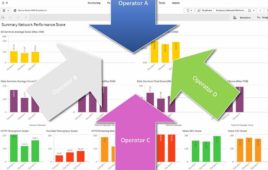Services Drive Data Adoption
A survey of European and U.S. mobile users shows consumers intend to dramatically increase use of mobile data services over the next two years, with a significant ramp-up in the next 12 months, according to a Tellabs-commissioned survey conducted by The Nielsen Company.
The research, conducted in the five larger Western European countries and the United States, analyzed 10 mobile data services. It shows that more than half of the approximately 200 million mobile data users in the surveyed countries expect to increase use in the next two years. The research also shows more than a quarter of the millions of consumers who do not use mobile data services today intend to start using them shortly.
 |
The detailed breakdown of the top five (above) services that non-users intend to start using shows that anticipated demand is not evenly split. U.S. consumers will drive more new mobile Internet use than Europeans: Around half of U.S. non-users of the mobile Internet intend to use it in the next two years, compared with a third of non-users in Europe.
Enterprise Applications Development Moves Ahead
 Despite economic turbulence and myriad platforms, 94 percent of corporate developers expect the development of wireless enterprise applications to either increase or stay the same in the coming year, with the strongest expectations for growth in the Asia-Pacific region, according to Evans Data. Only 6 percent of developers expect development efforts to decrease. Additionally, among commercial developers, two-thirds expect the average revenue per user to increase in 2009, according to the survey of over 400 wireless developers worldwide.
Despite economic turbulence and myriad platforms, 94 percent of corporate developers expect the development of wireless enterprise applications to either increase or stay the same in the coming year, with the strongest expectations for growth in the Asia-Pacific region, according to Evans Data. Only 6 percent of developers expect development efforts to decrease. Additionally, among commercial developers, two-thirds expect the average revenue per user to increase in 2009, according to the survey of over 400 wireless developers worldwide.
When selecting a wireless platform to target, money was the most important consideration by far, with revenue potential cited by a quarter of the developers and 21 percent identifying bigger marketing opportunities. By contrast, only 15 percent said platform openness was the most important consideration.
Other highlights of the survey:
- Forty percent more developers plan to target Windows Mobile than Apple iPhone, and 46 percent more plan to target .Net (compact framework) than Google’s Android platform.
- SOAP/XML RPC is currently being used by twice as many wireless developers as REST.
- Forty percent of wireless development projects take three to six months to complete, and 60 percent are completed in less than six months.
High Hopes for Mobile TV
The switchover to all-digital television broadcasting in the United States and other major countries will create an unprecedented opportunity for the mobile TV market, according to ABI Research. The research  firm forecasts mobile TV services could attract more than 500 million viewers by 2013.
firm forecasts mobile TV services could attract more than 500 million viewers by 2013.
It’s important to make the distinction between content streamed to mobile handsets over cellular networks and free-to-air broadcasting to mobile devices equipped with mobile TV tuners, analysts say. “Mobile TV users have yet to value the medium properly because it has not been validated as an independent product and service,” says senior analyst Jeff Orr. “It has been primarily offered at the end of a long list of more preferred cellular services. However, mobile TV will soon be positioned in a more proper role as an extension of traditional broadcast TV services.”
“Mobile TV viewing will not solely be on cellular handsets but also on MIDs, and automotive infotainment systems. I believe that once the content is available and the services launched, mobile TV will enable more classes of mobile devices that are ‘natural fits’ for mobile entertainment,” Orr adds.
The ones who benefit will be content developers and providers; device vendors, especially mobile Internet device and cellular handset OEMs; and service providers. Other winners include multimedia and security software, semiconductor and network infrastructure vendors. Once mobile TV users adopt the service at high growth levels, advertisers will also climb on board.
Consumers Tap Into Wi-Fi
 Consumer usage of Wi-Fi to access the mobile Internet is widespread across the United States, according to mobile advertising marketplace provider AdMob. The West and Northeast experienced heavier Wi-Fi usage by population than the South and Midwest in January. The states that generated the most Wi-Fi traffic were California with 18 percent, New York with 14 percent and Texas with 8 percent.
Consumer usage of Wi-Fi to access the mobile Internet is widespread across the United States, according to mobile advertising marketplace provider AdMob. The West and Northeast experienced heavier Wi-Fi usage by population than the South and Midwest in January. The states that generated the most Wi-Fi traffic were California with 18 percent, New York with 14 percent and Texas with 8 percent.




